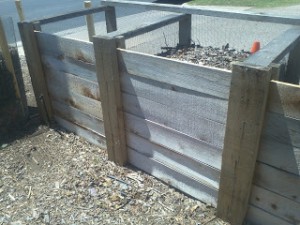Soils in Central Texas Are Challenging
Great gardens begin with great soils and composting. Most folks don’t start with ideal soil when they purchase a new property or decide to try gardening for the first time. Too sandy, too much clay, too shallow, too hard and dry… you name it and we gardeners have dealt with it.
Here in Central Texas, a few folks enjoy the benefits of a deep, alluvial soil alongside a river or creek. Others fight the black clay that holds water like a fish bowl when it rains, but dries like concrete when it doesn’t. In summer giant cracks appear large enough to lose a small child playing out in the yard.
Still other gardeners, especially in the western parts of the area, have large rock outcroppings on which only a thin layer of soil remains. These soils lack the depth to hold much water and are prone to drought. There are plants that are designed to grow in such conditions, but most of our garden and landscape plants and turfgrasses are not adapted to such stressful conditions. You might as well spread a 4 inch layer of potting soil on the driveway and try to grow a lawn or flower bed on that thin layer…good luck and you better have a water hose nearby.
Soil Improvement in Austin Area
If you want to be successful at growing things here in the Austin area, some soil improvement may be in order. The two key things most often needed are compost to improve the quality of soil and more soil depth to support a strong, extensive and resilient root system.
Compost Replenishes Organic Matter
Nearly all soils in Central Texas lack organic matter. The relatively warm nights and lack of sustained cold periods allow soil microbes to deplete soils of available materials to decompose. This works great for prairie ecosystem, but without all that grass, our soils need supplemental organic matter.
You can improve your soil, and over time turn that parched patch of earth into a Garden of Eden, by making your own compost or mulch. You can also purchase compost by truckload or bag. Here is a resource you can use to calculate how much you’ll need.
Soil Depth
A soil depth of 6” is minimal for lawn grasses but more is better. Turf on shallower soils will be weak and require constant watering just to keep it alive. Flowers and vegetables also need 6-12 inches of soil to do well. Many gardeners find success in building up raised planting beds to turn a shallow rocky soil or compacted heavy soil into a beautiful garden spot.
Get Your Soil Tested
Our central Texas soils are usually high in pH levels making them well suited to our western native plants and ill adapted to acid-loving plants of the southeast like azaleas and blueberries. Our soils typically have high levels of phosphorus and potassium but may need some additions of nutrients for optimum plant growth. The best way to tell what your soil needs is to have it tested. Texas A&M AgriLife Extension Soil, Water, and Forage Testing Laboratory has the form and the instructions on how to do this. You can find the link here: https://soiltesting.tamu.edu/files/urbansoil.pdf
Travis County Soil Survey
The United States Department of Agriculture, Soil Conservation Service conducted field work in the late 1960’s to create a soil map of Travis County. The information gathered can be applied in managing farms and ranches; in selecting sites for roads, ponds, buildings, and other structures; and in judging the suitability of tracts of land for farming, industry, and recreation. If you’re ready to deep dive into soil types, this is the information for you. The interactive tool allows you to input your address and discover which soil series has been mapped to your property.
Determine Soil Texture
Identifying your soil texture will help you make better decisions about irrigation, fertilizing, and composting. There are two ways to do this: by feel, and by the Jar Test. Learn more about determining texture by combining soil and water in your hands here: https://travis-tx.tamu.edu/files/2023/09/Soil-texture-by-feel-handout.pdf. Learn more about determining texture through a jar test here: https://hgic.clemson.edu/factsheet/soil-texture-analysis-the-jar-test/.
Money Well Spent
Spend a dollar on your soil before you spend a dollar on your plants, and you’ll save money in the long run and have a much better garden to show for it. Spend time to learn more about soil testing, soil nutrients, fertilizing, and ways to make and use composted organic matter to grow a better soil, season after season.
So go ahead, dive in, and get the real dirt on building better soil.
Additional Resources for Soils and Composting
- Using Coffee Grounds in the Garden
- Great Gardens Begin with Great Soil
- How to Take A Soil Sample
- Texas A&M AgriLife Extension Soil, Water, and Forage Testing Laboratory
- Calculate Amount of Soil, Mulch, or Compost to Purchase or Make
- Soil Survey of Travis County Texas
- The Real Dirt on Austin Area Soils
- Soil Texture by Feel and Related Properties
- Soil Texture by Jar Test
- Compost Brings Life
- Don’t Bag it, Compost it!
- Leaf Management Plan
- Recycling Leaves – From Trash to Treasure
- Vermiculture
- USDA Backyard Conservation: Composting

